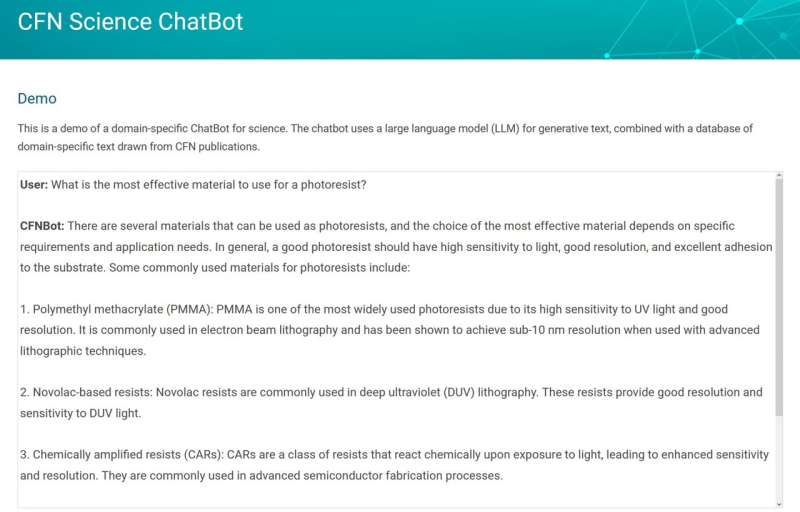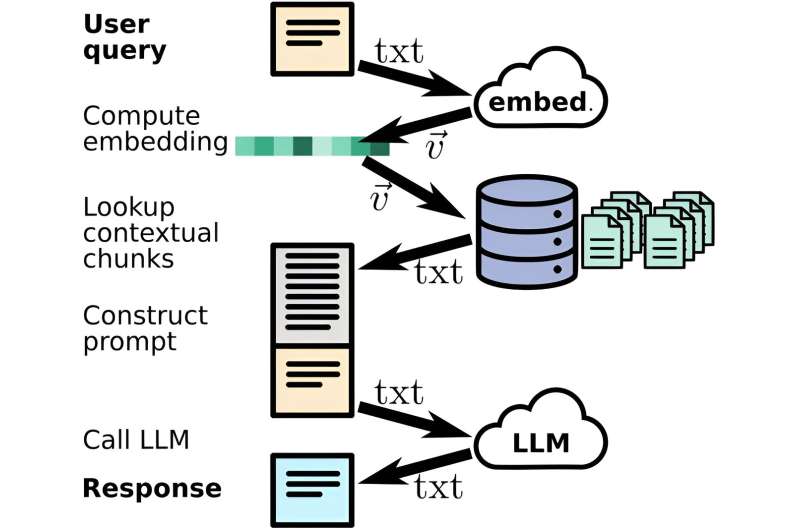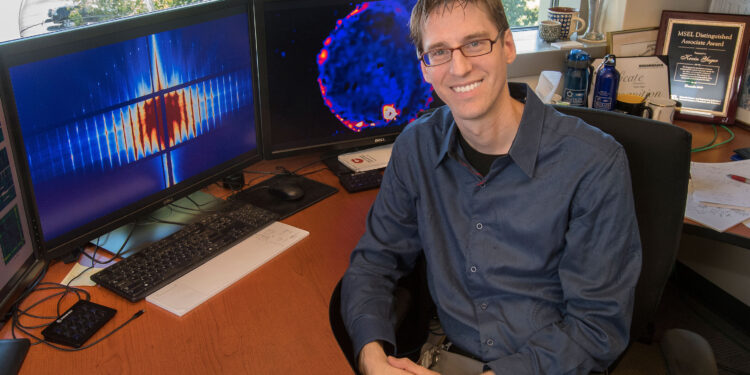Kevin Yager. Credit: Joseph Rubino/Brookhaven National Laboratory
A researcher has just finished writing a scientific article. She knows her work could benefit from another perspective. Did she forget something? Or maybe there’s an application of her research that she hadn’t thought of. A second pair of eyes would be great, but even the nicest employee might not be able to take the time to read all the basic publications needed to catch up.
Kevin Yager, leader of the Electronic Nanomaterials Group at the Center for Functional Nanomaterials (CFN), a U.S. Department of Energy (DOE) Science User Office at DOE’s Brookhaven National Laboratory, imagined how recent advances in nanomaterials Artificial intelligence (AI) and machine learning (ML) could facilitate scientific brainstorming and ideation. To do this, he developed a chatbot with knowledge in the types of sciences in which he is engaged.
Rapid advances in AI and ML have given way to programs capable of generating creative text and useful software code. These general-purpose chatbots have recently captured the public imagination. Existing chatbots, based on broad and diverse linguistic models, lack detailed knowledge about scientific subdomains.
By exploiting a method of document retrieval, Yager’s robot has knowledge in areas of nanomaterial science that other robots do not possess. Details of this project and how other scientists can leverage this AI colleague for their own work were recently published in Digital discovery.
The rise of robots
“CFN has long explored new ways to leverage AI/ML to accelerate the discovery of nanomaterials. Currently, it helps us quickly identify, catalog and choose samples, automate experiments, control equipment and discover new materials. Esther Tsai, a scientist in CFN’s Electronic Nanomaterials Group, is developing an AI companion to help accelerate materials research experiments at the National Synchrotron Light Source II (NSLS-II).” NSLS-II is another DOE Office of Science user facility at Brookhaven Lab.
At CFN, there has been a lot of work done on AI/ML that can help run experiments through the use of automation, controls, robotics, and analytics, but have a program adapted to scientific texts was something that researchers had not explored. so deeply. Being able to quickly document, understand, and convey information about an experiment can help in many ways, from eliminating language barriers to saving time summarizing larger works.

A demo of Yager’s chatbot answering a question related to CFN research. Credit: Brookhaven National Laboratory
Watch your tongue
To create a specialized chatbot, the program required domain-specific text, language drawn from the areas the bot is intended to focus on. In this case, the text is a scientific publication. Domain-specific text helps the AI model understand new terminology and definitions and introduces it to cutting-edge scientific concepts. More importantly, this set of documents allows the AI model to base its reasoning on reliable facts.
To mimic natural human language, AI models are trained on existing text, allowing them to learn the structure of language, memorize various facts, and develop a primitive type of reasoning. Rather than laboriously retraining the AI model on nanoscience texts, Yager gave it the ability to search for relevant information in a curated set of publications. Providing him with a library of relevant data was only half the battle. To use this text accurately and effectively, the robot would need a way to decipher the correct context.
“A common challenge for language models is that sometimes they ‘hallucinate’ things that seem plausible but false,” Yager explained. “This has been a central problem to solve for a chatbot used in research, as opposed to one that does something like writing poetry. We don’t want it to fabricate facts or quotes. This problem had to be solved The solution to this problem was something we called “integration,” a way to quickly categorize and connect information behind the scenes.”
Embedding is a process that transforms words and sentences into numerical values. The resulting “embedding vector” quantifies the meaning of the text. When a user asks a question to the chatbot, it is also sent to the ML integration model to calculate its vector value. This vector is used to search a precomputed database of text chunks from scientific articles that have been similarly integrated. The robot then uses the text snippets found and semantically related to the question to obtain a more complete understanding of the context.
The user’s query and text snippets are combined into a “prompt” that is sent to a large language model, an extensive program that creates text modeled on natural human language, which generates the final response. Embedding ensures that the extracted text is relevant in the context of the user’s question. By providing pieces of text from the body of reliable documents, the chatbot generates factual and sourced responses.
“The program should be like a reference librarian,” Yager said. “It must rely heavily on documents to provide reliable answers. It must be able to accurately interpret what people are asking and be able to effectively piece together the context of those questions to retrieve the most relevant information Even though the answers may not yet be perfect, he is already capable of answering difficult questions and triggering interesting thoughts while planning new projects and research.

Credit: Brookhaven National Laboratory
Robots empower humans
CFN develops AI/ML systems as tools that can enable human researchers to work on harder, more interesting problems and make the most of their limited time while computers automate repetitive tasks backwards -plan. There are still many unknowns about this new way of working, but these questions mark the start of important discussions scientists are currently having to ensure the use of AI/ML is safe and ethical.
“There are a number of tasks that a domain-specific chatbot like this could eliminate from a scientist’s workload. Classifying and organizing documents, summarizing publications, highlighting relevant information, and getting started day in a new topical area are just some of the potential applications,” Yager noted. “I’m excited to see where this takes us, though. We could never have imagined where we are today three years ago, and I can’t wait to see where we will be three years from now.”
For researchers interested in trying this software for themselves, the source code for CFN’s chatbot and associated tools can be found in this GitHub repository.
More information:
Kevin G. Yager, Domain-Specific Chatbots for Science Using Integrations, Digital discovery (2023). DOI: 10.1039/D3DD00112A
Provided by Brookhaven National Laboratory
Quote: A researcher develops a chatbot with expertise in nanomaterials (December 1, 2023) retrieved on December 2, 2023 from
This document is subject to copyright. Except for fair use for private study or research purposes, no part may be reproduced without written permission. The content is provided for information only.



